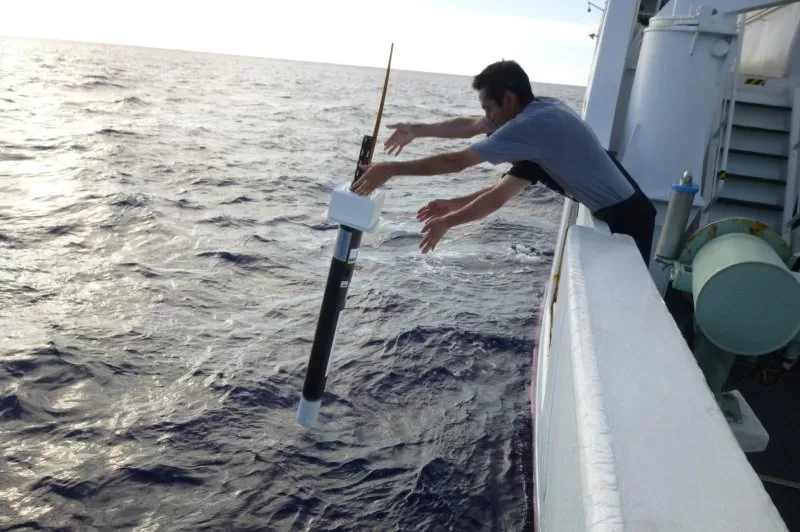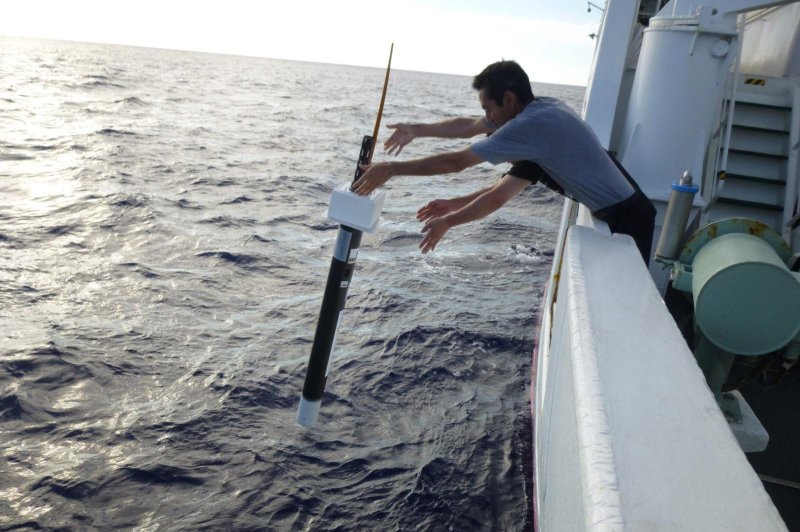1 of 4 | Two program technicians deploy an Argo float in the ocean recently. Photo courtesy of the University of California-San Diego
April 10 (UPI) — The National Oceanic and Atmospheric Administration is using $2.7 million in federal funding to deploy a new data-gathering device that will improve measurements of ocean temperatures and climate change, NOAA officials announced Wednesday.
The funding supports the development of OneArgo, which is an improved design of the thousands of floating instruments currently collecting data on water salinity and temperatures around the globe, according to NOAA and Department of Commerce officials.
“For 25 years, the Argo Program has provided more ocean data than any other observing instrument, helping NOAA revolutionize our understanding of the ocean and its role in Earth’s climate,” said U.S. Secretary of Commerce Gina Raimondo. “The new robotic floats will expand out assessments of ocean conditions, measurements and sea level rise as we continue to tackle the impacts of climate change.”
The NOAA describes the Argo array as a fleet of robotic instruments that measure the salinity and temperature on the world’s oceans.
The international Argo fleet numbers about 4,000 floats that dive 1.2 miles beneath the water’s surface once every 10 days to collect data on water temperature and salinity. When the floats surface, they transmit data to satellites.
The NOAA says the $2.7 million in federal funding will enable deployment of new OneArgo instruments to improve the number of readings and greater measurement data.
The OneArgo floats will be deployed in the Gulf of Mexico and the California Current Ecosystem, according to the NOAA. They also will be deployed in the Arctic and tropical Pacific oceans, where data collection is sparse.
The NOAA says the OneArgo floats are improved versions of the current Argo floats and can dive 3.7 miles beneath the surface to collect data on oxygen, carbon pH and other water conditions that help measure ocean acidification and oxygen levels.
“OneArgo exemplifies the type of services that NOAA provides to help improve climate science and resilience,” said NOAAA dministrator Rick Spinrad. “The pursuit of autonomous technology to fill critical observing gaps and provide essential data and tools for society will only become more important as we move into the future.”
The NOAA says the data gathered by the OneArgo instruments will help support:
- fisheries modeling and management
- predicting rising sea levels
- advanced seasonal weather forecasting
- marine carbon dioxide removal progress
The federal funding announced Wednesday will pay for deployment of 40 more Argo floats, seven deep-Argo floats and six biogeochemical floats.
The NOAA says the funding also enables development of data-management infrastructure that supports the Argo array.
The NOAA first deployed the Argo array in 2000 using floats that that collected a million data readings by November 2012 and 2 million readings in November 2018, according to the University of California-San Diego.
Most Argo program floats have batteries that power them for between four to five years.
The international Argo program has 26 participating nations and provides data that enables scientific assessments of water temperatures and climate change.








